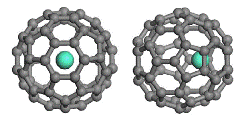Department of Chemistry
Document Type
Article
Date of this Version
2-1-2006
Abstract
Structures and relative stability of four families of low-lying silicon clusters in the size range of Sin(n=21–30) are studied, wherein two families of the clusters show prolate structures while the third one shows near-spherical structures. The prolate clusters in the first family can be assembled by connecting two small-sized magic clusters Sin(n=6, 7, 9, or 10) via a fused-puckered-hexagonal-ring Si9 unit (a fragment of bulk diamond silicon), while those in the second family can be constructed on the basis of a structural motif consisting of a puckered-hexagonal-ring Si6 unit (also a fragment of bulk diamond silicon) and a small-sized magic cluster Sin(n=6, 7, 9, or 10). For Si21–Si29, the predicted lowest-energy clusters (except Si27) exhibit prolate structures. For clusters larger than Si25, the third family of near-spherical clusters becomes energetically competitive. These near-spherical clusters all exhibit endohedral caged-like structures, and the cages are mostly homologue to the carbon-fullerene cages which consist of pentagons and hexagons exclusively. In addition, for Si26–Si30, we construct a new (fourth) family of low-lying clusters which have “Y-shaped” three-arm structures, where each arm is a small-sized magic cluster (Si6, Si7, or Si10). Density-functional calculation with the B3LYP functional shows that this new family of clusters is also energetically competitive, compared to the two prolate and one near-spherical low-lying families.



Comments
Published by American Institute of Physics. J. Chem. Physics 124, 054304 2006. ©2006 American Institute of Physics. Permission to use. http://jcp.aip.org/.